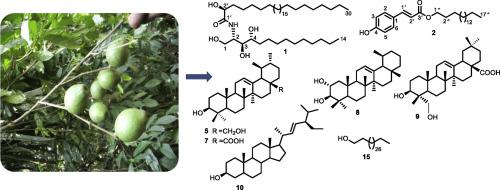当前位置:
X-MOL 学术
›
Biochem. Syst. Ecol.
›
论文详情
Our official English website, www.x-mol.net, welcomes your feedback! (Note: you will need to create a separate account there.)
Rothmanniamide and other constituents from the leaves of Rothmannia hispida (K.Schum.) fagerl. (Rubiaceae) and their chemophenetic significance
Biochemical Systematics and Ecology ( IF 1.6 ) Pub Date : 2020-12-01 , DOI: 10.1016/j.bse.2020.104137 Argan Kelly Nkwenti Wonkam , Cyrille Armel Njanpa Ngansop , Steven Collins Njonte Wouamba , Jean Bosco Jouda , Gervais Mouthe Happi , Fabrice Fekam Boyom , Norbert Sewald , Bruno Ndjakou Lenta
Biochemical Systematics and Ecology ( IF 1.6 ) Pub Date : 2020-12-01 , DOI: 10.1016/j.bse.2020.104137 Argan Kelly Nkwenti Wonkam , Cyrille Armel Njanpa Ngansop , Steven Collins Njonte Wouamba , Jean Bosco Jouda , Gervais Mouthe Happi , Fabrice Fekam Boyom , Norbert Sewald , Bruno Ndjakou Lenta

|
Abstract The chemical investigation of the CH2Cl2/MeOH (1:1) extract of the leaves of Rothmannia hispida (K. Schum.) Fagerl. (Rubiaceae) led to the isolation of a new ceramide rothmanniamide (1) and a naturally isolated alkyl cinnamate derivative n-heptadecyl-4-hydroxy-trans-cinnamate (2), along with fifteen known compounds including lupeol palmitate (3), lupeol (4), a mixture of uvaol (5) and erythrodiol (6), ursolic acid (7), 30-nor-2α,3β-dihydroxyurs-12-ene (8), hederagenin (9), stigmast-22-en-3-ol (10), a mixture of β-sitosterol (11) and stigmasterol (12), stigmast-4,22-dien-3-ol (13), stigmasterol 3-O-β-D-glucoside (14), triacontan-1-ol (15), kaempferol 3-O-β-D-glucopyranoside (16) and D-mannitol (17). Their structures were elucidated with the help of MS and NMR data. Compounds 8, 10 and 15 were isolated for the first time from the Rubiaceae family. The crude extract and the isolates were assessed in vitro for their antileishmanial activity against Leishmania donovani 1 S (MHOM/SD/62/1 S) promastigotes and cytotoxicity on RAW 264.7 macrophage cells. Compounds 7 and 8 exhibited a highly potent antileishmanial activity with IC50 values of 0.88 and 1.75 μg/mL, respectively, with good selectivity indexes (SI > 57). The chemophenetic significance of these compounds is also discussed.
中文翻译:

Rothmanniaamide 和来自 Rothmannia hispida (K.Schum.) fagerl 叶子的其他成分。(茜草科)及其化学表观意义
摘要 Rothmannia hispida (K. Schum.) Fagerl 叶子的 CH2Cl2/MeOH (1:1) 提取物的化学研究。(茜草科)导致分离出一种新的神经酰胺 rothmanniamide (1) 和一种天然分离的肉桂酸烷基酯衍生物 n-十七烷基-4-羟基-反式肉桂酸酯 (2),以及十五种已知化合物,包括羽扇豆醇棕榈酸酯 (3)、羽扇豆醇(4)、uvaol (5) 和高根二醇 (6) 的混合物、熊果酸 (7)、30-nor-2α,3β-dihydroxyurs-12-ene (8)、hederagenin (9)、stigmast-22-en -3-ol (10)、β-谷甾醇 (11) 和豆甾醇 (12) 的混合物、stigmast-4,22-dien-3-ol (13)、豆甾醇 3-O-β-D-葡萄糖苷 (14) )、三十烷醇 (15)、山奈酚 3-O-β-D-吡喃葡萄糖苷 (16) 和 D-甘露醇 (17)。借助 MS 和 NMR 数据阐明了它们的结构。化合物 8, 10和15是首次从茜草科中分离得到。在体外评估了粗提取物和分离物对多诺瓦利什曼原虫 1 S (MHOM/SD/62/1 S) 前鞭毛体的抗利什曼原虫活性和对 RAW 264.7 巨噬细胞的细胞毒性。化合物 7 和 8 表现出高效的抗利什曼原虫活性,IC50 值分别为 0.88 和 1.75 μg/mL,具有良好的选择性指数(SI > 57)。还讨论了这些化合物的化学表观意义。具有良好的选择性指数 (SI > 57)。还讨论了这些化合物的化学表观意义。具有良好的选择性指数 (SI > 57)。还讨论了这些化合物的化学表观意义。
更新日期:2020-12-01
中文翻译:

Rothmanniaamide 和来自 Rothmannia hispida (K.Schum.) fagerl 叶子的其他成分。(茜草科)及其化学表观意义
摘要 Rothmannia hispida (K. Schum.) Fagerl 叶子的 CH2Cl2/MeOH (1:1) 提取物的化学研究。(茜草科)导致分离出一种新的神经酰胺 rothmanniamide (1) 和一种天然分离的肉桂酸烷基酯衍生物 n-十七烷基-4-羟基-反式肉桂酸酯 (2),以及十五种已知化合物,包括羽扇豆醇棕榈酸酯 (3)、羽扇豆醇(4)、uvaol (5) 和高根二醇 (6) 的混合物、熊果酸 (7)、30-nor-2α,3β-dihydroxyurs-12-ene (8)、hederagenin (9)、stigmast-22-en -3-ol (10)、β-谷甾醇 (11) 和豆甾醇 (12) 的混合物、stigmast-4,22-dien-3-ol (13)、豆甾醇 3-O-β-D-葡萄糖苷 (14) )、三十烷醇 (15)、山奈酚 3-O-β-D-吡喃葡萄糖苷 (16) 和 D-甘露醇 (17)。借助 MS 和 NMR 数据阐明了它们的结构。化合物 8, 10和15是首次从茜草科中分离得到。在体外评估了粗提取物和分离物对多诺瓦利什曼原虫 1 S (MHOM/SD/62/1 S) 前鞭毛体的抗利什曼原虫活性和对 RAW 264.7 巨噬细胞的细胞毒性。化合物 7 和 8 表现出高效的抗利什曼原虫活性,IC50 值分别为 0.88 和 1.75 μg/mL,具有良好的选择性指数(SI > 57)。还讨论了这些化合物的化学表观意义。具有良好的选择性指数 (SI > 57)。还讨论了这些化合物的化学表观意义。具有良好的选择性指数 (SI > 57)。还讨论了这些化合物的化学表观意义。



























 京公网安备 11010802027423号
京公网安备 11010802027423号